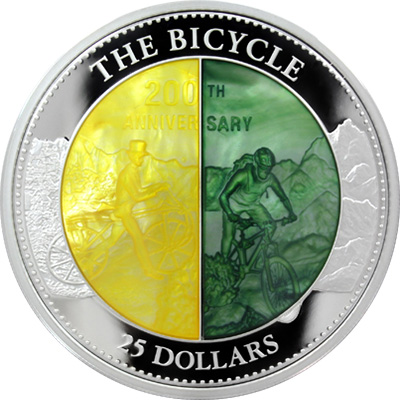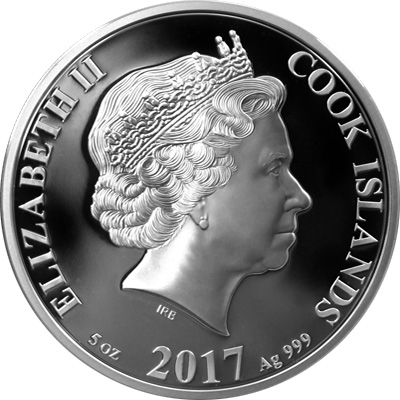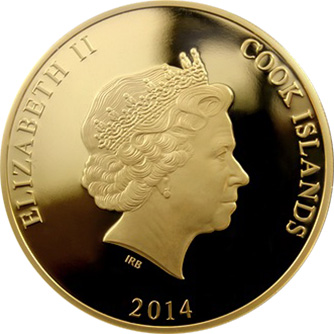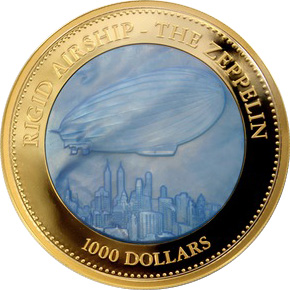Gold Coin 5 Oz Bicycle 200th Anniversary 2017 Proof Pearl
The product cannot be ordered now.
NOT IN STOCK
Detailed description
World premiere - two-colour pearl in gold coin
Following the huge success of the silver and gold coins with mother-of-pearl issued in previous years, the Cook Islands is releasing another unique gold coin with mother-of-pearl for 2017, commemorating the 200th anniversary of the invention of the bicycle.
Issued by the Cook Islands State, this five-ounce (155.5g) coin is minted in the purest 99.9% gold purity and features an inner core of real mother-of-pearl, available in two colours for the first time ever.
Each of the two mother-of-pearl semicircles on the reverse of the coin depicts a precise motif of a man on a bicycle. The yellow semicircle (left) characterizes the time of the bicycle's inception, while the green (right) depicts a mountain bike racer, marking the progress in the development of one of the world's most widely used means of transportation during its existence. The outer circle bears the inscriptions "THE BICYCLE" and the denomination. The obverse shows a traditional portrait of Britain's Queen Elizabeth II by Ian-Rank Broadley and the inscriptions "ELIZABETH II", "COOK ISLANDS", the year of issue and the artist's initials "IRB".
The coin comes in a deluxe gift case, in the shape of a wooden wheel, along with a numbered certificate of authenticity in an extremely limited edition of only 25 pieces for the entire world!
A bicycle (older name bicycle, for short just bicycle) is a single-track vehicle, powered by the force of human muscles, possibly assisted by a motor (e.g. electric bicycle). The human energy transferred by the limbs, usually the lower limbs, to the pedals of the bicycle is converted via gears and chain into the rotation of the wheel, usually the rear wheel, which then performs the movement on the ground. In many regions it is the main means of transport, elsewhere it is used for recreational rides, sports or as a fitness machine. Between 1992 and 2002, more than one billion bicycles were produced worldwide and production is still rising.
In 1817, Karl Drais invented the Draisina, or dressage bike, in Karlsruhe, in present-day Germany, which worked on the principle of today's children's bicycle. It had a steerable front wheel and the rider bounced off the ground with his feet. The machine was wooden except for iron fasteners, had spoked wheels with iron hoops, a leather saddle and a support bar as a stand.
In 1861 Pierre Michaux changed the drive from bouncing to pedalling via single-speed fixed cranks on the front wheel. He called the means of transport "vélocipede" in the Paris factory of Michaux & Lallement began mass-producing the velocipede with great success. They began to be produced in other factories, mainly in England, where they were already made all-metal with wire wheels. There was also progress in the use of narrow rubber hoops instead of steel rims and in the development of saddle suspension. High Wheel Quad Bicycle for Two, 1886, White House, Washington, D.C.
In 1870 came the innovation of the high wheel, which increased the pedaling efficiency of fixed gear by enlarging the front wheel. However, this had the major disadvantage of the instability of the high centre of gravity and the danger of a possible fall from the wheel. Not everyone could ride such a tall bike, so a three or four-wheeler (tricycle or quad bike) was also produced with two large wheels at the rear and one or two small ones at the front or rear, allowing two riders to ride.
In 1878, Scott and Phillott of England patented the first planetary gearbox in a front-drive bicycle. Ladies' safety bicycle, 1889.
In 1879, Henry J. Lawson of England patented a chain transmission of power from the cranks to the rear wheel. This was the first bicycle with a lower center of gravity and a trend called the "safety bicycle".
In 1896, Sir Frank Boden patented a more efficient type of cable braking, which eventually replaced the existing tire pressure brakes.
Next, the anti-skid brake was developed, known in the Czech lands by the product name "torpedo", whereby the braking force went directly to the centre of the rear wheel. There were no wheel accessories for a long time, until around 1895 the first primitive lights and the first canvas mudguards, then called "mudguards", started to be produced. By the early 20th century, tall wheels were displaced by the more or less contemporary type of sprocketed wheel. Bicycles were also specialised for specific purposes: for example, the folding military bicycle, the railway drayage adapted to railways and the 'hydrocycle', a bicycle with floats. Another landmark was the invention of the mountain bike in the late 1970s and early 1980s.
This product is part of the following product sets:
Mother of Pearl series The fascinating world of means of transportProduct Specifications
Application form
Thanks to our position on the market, we can try to provide you with a product that is currently sold out or unavailable for a longer period of time. Simply fill in the application form and we will contact you as soon as we are able to secure the product.
Filling in the application form is not binding for you.
Buyback contact form
We will be happy to buy investment metals purchased from us or from our competitors. Our customers always get the highest price offered at any given time. Fill out the form below and we will contact you. Thank you for your trust.
































